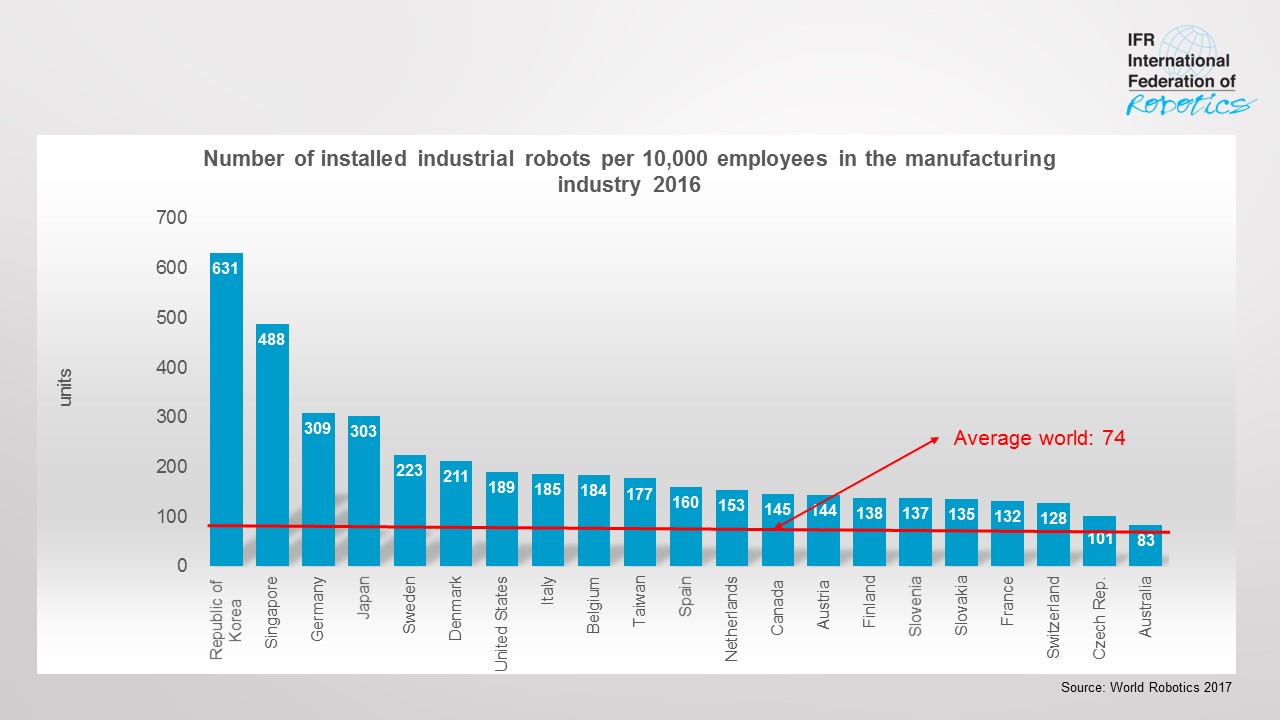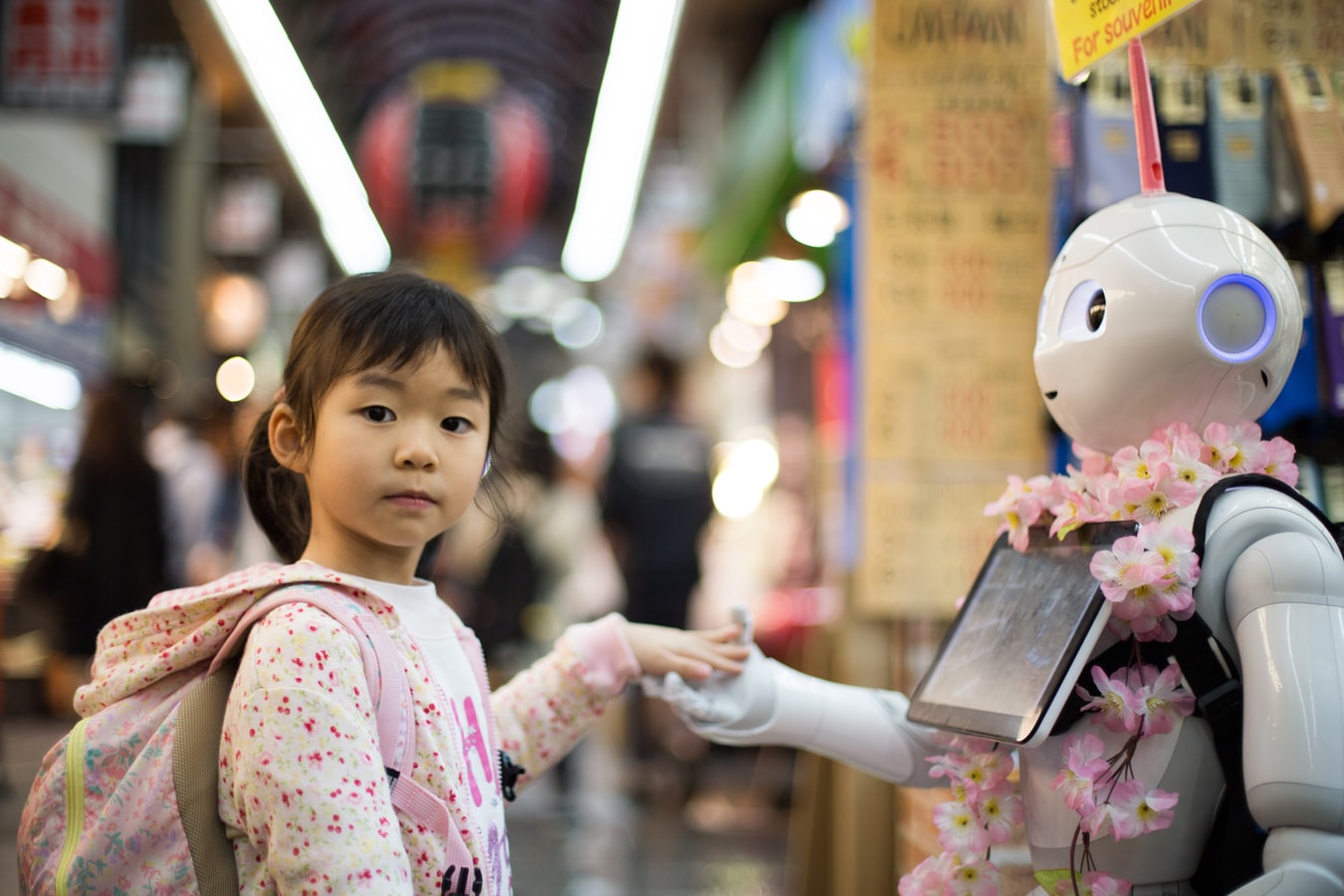Unit 3 Robotics around the World

In 2017, nearly 2 million industrial robots were in use around the world, up nearly 280% since 1993. The use of robots has more than doubled in the last 20 years in most advanced economies. The top users of industrial robots in 2017 were China, Japan and South Korea, using nearly 50% of the world’s stock of robots. European nations were also significant users of industrial robots in 2017, with Germany employing around 200,000 robots.
Source: Adapted from the article “Which Countries and Industries Use the Most Robots?” (Federal Reserve Bank of St. Louis 2019).
3.1 Reading: Robot Density Rises Globally
The automation of production is accelerating around the world. 74 robot units per 10,000 employees is the new average of global robot density in the manufacturing industries (2015: 66 units). By regions, the average robot density in Europe is 99 units, in the Americas 84 and in Asia 63 units.
 The 2017 World Robot Statistics, issued by the International Federation of Robotics (IFR)
The 2017 World Robot Statistics, issued by the International Federation of Robotics (IFR)
“Robot density is an excellent standard for comparison in order to take into account the differences in the automation degree of the manufacturing industry in various countries,” says Junji Tsuda, President of the International Federation of Robotics. “As a result of the high volume of robot installations in Asia in recent years, the region has the highest growth rate. Between 2010 and 2016, the average annual growth rate of robot density in Asia was 9 percent, in the Americas 7 percent and in Europe 5 percent.”
Source: Adapted from the article “Robot density rises globally” (IFR 2018).
- In 2017, what is the average of global robot density in the manufacturing industries?
- Is it higher or lower that that of 2015?
- Which continent has the highest average robot density?
- Accoriding to the 2017 World Robot Statistics, what is the most automated country in the world?
- Between 2010 and 2016, was the average annual growth rate of robot density in Asia 7 percent?
Show/Hide solution
- 74 per 10,000 employees; 2. Higher; 3. Europe; 4. Republic of Korea; 5. No, 9 percent.
- Republic of Korea
Show/Hide solution
1.Republic of Korea 2.Singapore 3.Germany 4.Japan 5.SwedenShow/Hide solution
6.Denmark 7.USA 8.Italy 9.Belgium 10.Taiwan3.2 Writing: What is Your Favorite Robot Company?
KUKA is a German manufacturer of industrial robots and solutions for factory automation. The company was founded in 1898 in Augsburg, Germany, by Johann Josef Keller and Jacob Knappich. While previously emphasizing customers in the automotive industry, the company has since expanded to other industries. The KUKA Robotics Corporation has 25 subsidiaries worldwide, mostly sales and service subsidiaries, including in the United States, Australia, Canada, Mexico, Brazil, China, Japan, South Korea, Taiwan, India, Russia and most European countries.
3.3 Speaking: Should Robots Be Different in Your Country?

3.4 Listening: Robotics in Germany
With their love of mechanical engineering,
Germany is among the world’s
And German turnover in robotics and automation has grown by
What’s more, industry experts predict annual growth of
What are some of the current trends?
One is that robots and human beings are working together.
This can take the form of
Another form of man-plus-machine are
It helps workers do heavy and repetitive lifting and won its parent company the prestigious German
Traditional industrial robots were built to carry out one task or set of tasks ad infinitum. But that too is changing.
The next generation of robots will be adaptable to a multitude of jobs.
Case in point: the Panda power tool from Munich company Franka Emika which is billed as the fastest selling industry suited robot in the world.
Show/Hide solution
Germans; top five; 50; 10.4; 15.7; 12; cobots; exoskeletons; entrepreneur3.5 My Glossary
Translate these terms into your language.